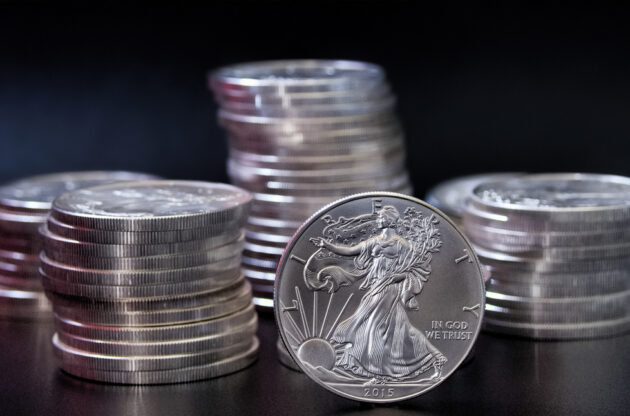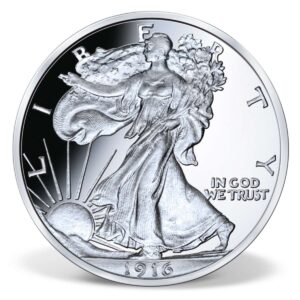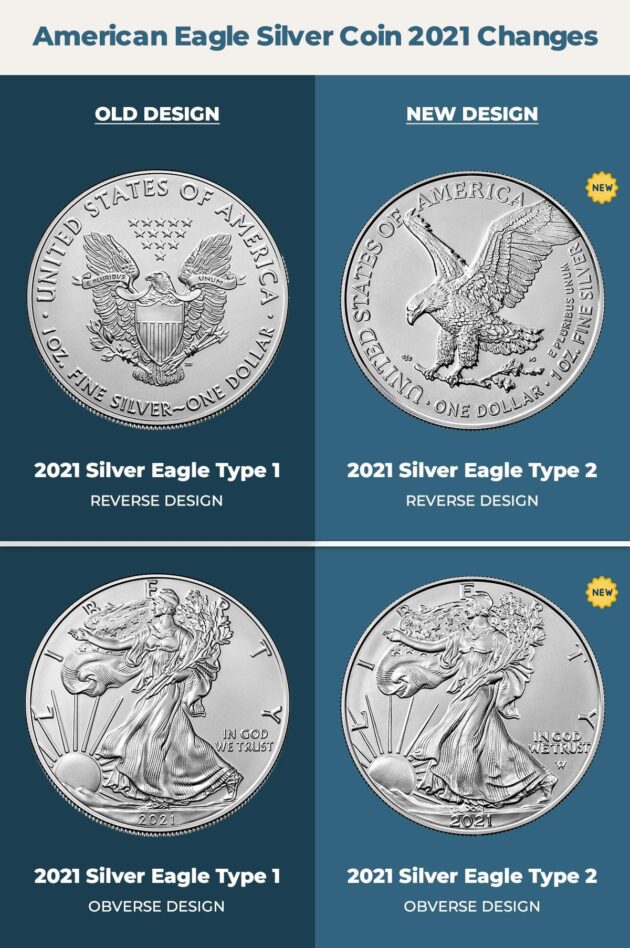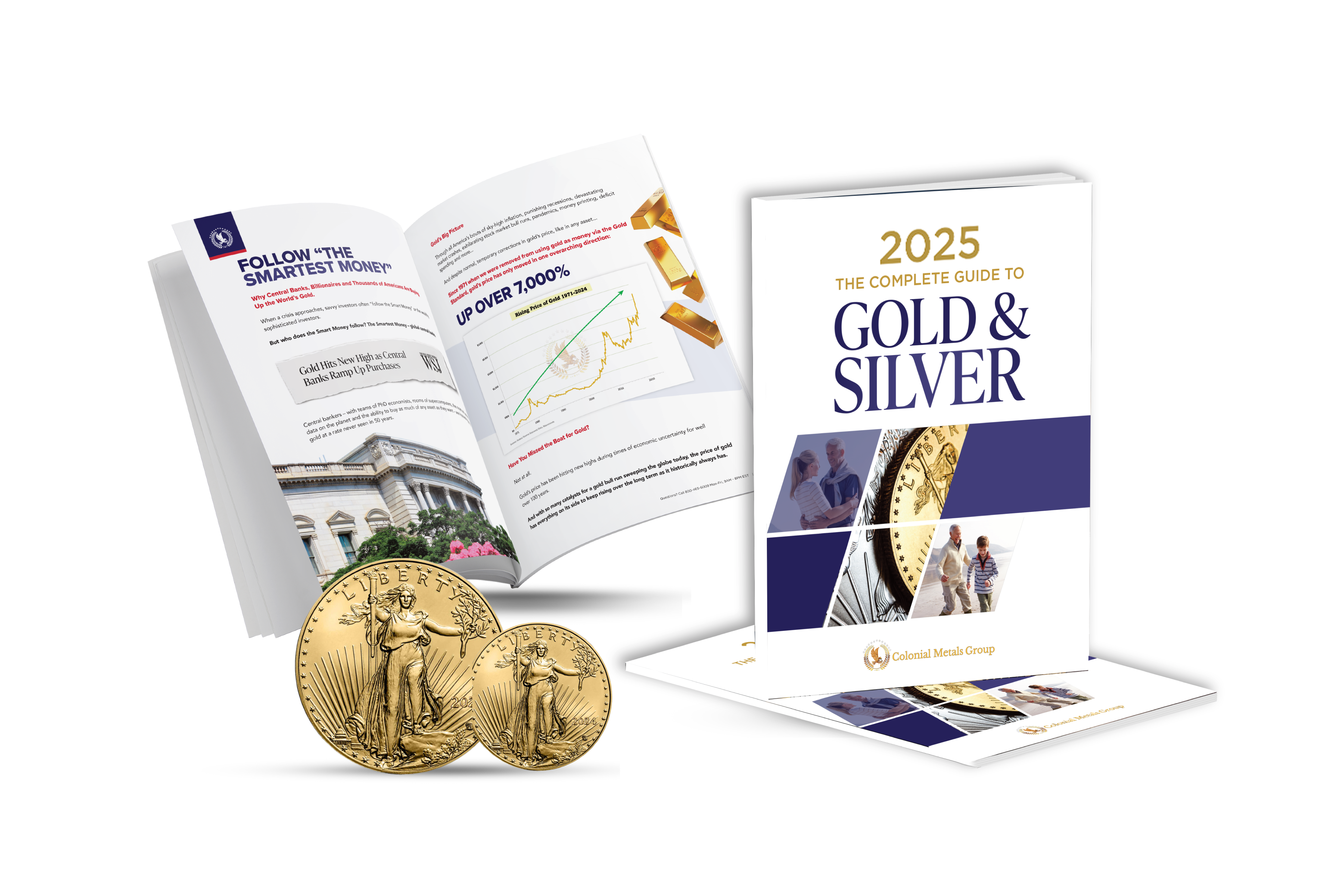
The American Silver Eagle stands as the United States’ official silver bullion coin, representing a perfect blend of artistic excellence, investment potential, and American heritage.
First authorized by the Liberty Coin Act of 1985 and introduced in 1986, the American Silver Eagle has become the world’s most popular and recognizable silver bullion coin, with over 650 million pieces minted to date.
Did you know… The American Silver Eagle program was launched in tandem with the Gold Eagle program in 1986, but the Silver Eagle was actually created for an additional purpose: to help the U.S. government reduce its stockpile of strategic silver reserves accumulated from the Defense National Stockpile!
1. Historical Foundations and Origins of the American Silver Eagle Program
The American Silver Eagle emerged from specific legislative and economic circumstances in the mid-1980s. Senator McClure of Idaho spearheaded the effort to create a market for the government’s substantial silver reserves while providing American investors with a trusted bullion option.
The Liberty Coin Act, signed by President Reagan on July 9, 1985, authorized the creation of the American Silver Eagle as the official silver bullion coin of the United States. This legislation established several key requirements:
- Each coin must contain precisely one troy ounce of 99.9% pure silver.
- The obverse would feature Adolph A. Weinman’s classic “Walking Liberty” design from the half dollar (1916-1947).
- The reverse would display a heraldic eagle design.
- The coins would have legal tender status with a face value of one dollar.
- Initial silver would come from the Defense National Stockpile.
The first American Silver Eagles were released on November 24, 1986, beginning one of the most successful government bullion programs in history. Unlike the Gold Eagle program with its multiple denominations, the Silver Eagle has been produced exclusively as a one-ounce coin throughout its history.
Did you know… The U.S. government initially set the price of American Silver Eagles at $1.50 over the spot price of silver. Today, the premium varies with market conditions.
2. Iconic American Silver Eagle Design Elements
The American Silver Eagle features designs of tremendous artistic and historical significance.
2.1 The Weinman Obverse: Walking Liberty’s Enduring Appeal
The obverse of the American Silver Eagle features Adolph A. Weinman’s iconic “Walking Liberty” design, originally created for the half dollar in 1916. Lady Liberty is depicted striding toward the dawn, draped in the American flag, her right arm extended, and her left arm carrying laurel and oak branches, symbolizing civilian and military glory.

The design represents national optimism and forward progress, with Liberty walking toward the rising sun. For the American Silver Eagle, the design was faithfully reproduced in its entirety, with minor modifications to enhance the detail and striking quality for the larger silver dollar format.
Did you know… Adolph Weinman was a former student of Augustus Saint-Gaudens, who designed the Gold Eagle’s obverse. Both artists’ work was selected as part of President Theodore Roosevelt’s initiative to beautify American coinage in the early 20th century!
2.2 The Reverse Design: From Heraldic Legacy to Natural Portrait
The American Silver Eagle has featured two distinct reverse designs:
The Mercanti “Heraldic Eagle” (1986-2021)
John Mercanti, the U.S. Mint’s Chief Engraver from 2006 to 2010, created the original reverse design featuring a heraldic eagle with outstretched wings, holding an olive branch in its right talon and arrows in its left. Above the eagle is a banner with “E PLURIBUS UNUM” (“Out of many, one”), and the eagle is surrounded by 13 stars representing the original colonies. This design adorned the coins from 1986 to 2021 and is known as the Type 1 design.
The heraldic eagle design combined elements from the Great Seal of the United States with classical numismatic traditions, creating a design that was both historically significant and distinctly American.
The Jeppson Eagle Landing (2021-present)
In 2021, for the 35th anniversary of the program, the U.S. Mint introduced a completely new reverse design by artist Emily Damstra, as sculpted by Michael Gaudioso. This design features a naturalistic bald eagle coming in for a landing, carrying an oak branch as if returning to its nest.

Damstra’s design emphasizes natural wildlife art over heraldic symbolism, showing the eagle in a dynamic, realistic pose that showcases the bird’s power and grace. This change marked the first major design modification in the Silver Eagle’s history and is known as the Type 2 design.
Did you know… The Type 2 Silver Eagle reverse design was selected from over 30 candidates and went through an extensive review process involving the Citizens Coinage Advisory Committee, the Commission of Fine Arts, and the Treasury Secretary!
2.3 Notable Design Changes Over Time
Several other notable changes have occurred during the Silver Eagle’s history:
- 2008: The “W” mint mark was added to uncirculated versions for the first time.
- 2021: Along with the new reverse, the Weinman obverse was enhanced with restored details from Weinman’s original 1916 design.
- 1995-W Proof: Issued only in the 10th Anniversary American Eagle Set, this is the rarest Silver Eagle with a mintage of just 30,125.
2.4 Anti-Counterfeiting Innovations (2021-2025)
The 2021 redesign also included significant security enhancements:
- Reeded edge variation with different reed count than previous issues
- Anti-counterfeiting “notches” or interruptions in the reeded edge
- Microscopic laser-engraved security features visible only under magnification
- Changes to the placement and style of inscriptions adding complexity for potential counterfeiters
The Mint has established a dedicated Anti-Counterfeiting Task Force to continue developing new security features for future releases, recognizing the Silver Eagle’s status as one of the most frequently counterfeited bullion coins.
Did you know… The 2021 redesign of the American Silver Eagle includes covert security features that the U.S. Mint has intentionally kept secret, creating additional challenges for potential counterfeiters!
3. Physical Specifications and Composition
The American Silver Eagle maintains consistent specifications that have remained essentially unchanged since 1986, with some minor production modifications over time.
3.1 Silver Content and Composition
The American Silver Eagle contains exactly:
- 1.000 troy ounce (31.103 grams) of 99.9% pure silver
- No alloy metals are added; the .999 fine silver composition ensures maximum purity
The silver used for American Silver Eagles originally came from the Defense National Stockpile. When this source was depleted in 2002, the Mint began sourcing silver from open market purchases of newly mined domestic silver.
3.2 Physical Dimensions of American Silver Eagle Coins
The American Silver Eagle’s specifications are as follows:
- Diameter: 40.6 mm (1.598 inches)
- Thickness: 2.98 mm (0.117 inches)
- Weight: 31.103 grams (1.000 troy ounce)
- Edge: Reeded (serrated) with approximately 198 reeds
- Face Value: One Dollar (legal tender)
These dimensions make it notably larger than a standard U.S. dollar coin, which has a diameter of 26.5 mm. The large format provides an impressive canvas for the detailed artistic designs.
Did you know… While the American Silver Eagle has a face value of just $1, its silver content has never been worth less than around $4 (in 2001) and has reached as high as $48 (in 2011) based on silver spot prices!
3.3 Legal Tender Status
The American Silver Eagle is legal tender with a face value of one dollar. While this nominal value is far below its silver content and collector value, it provides several advantages:
- Government backing of weight and purity
- Potential classification as “currency” rather than “collectible” in some tax scenarios
- Simplified import/export regulations in many jurisdictions
- Enhanced collector appeal over privately minted products
3.4 Specification Summary
- Silver Content: 1.000 troy oz (31.103 g)
- Silver Purity: 99.9% (.999 fine silver)
- Total Weight: 31.103 g (1.000 troy oz)
- Diameter: 40.6 mm (1.598 inches)
- Thickness: 2.98 mm (0.117 inches)
- Edge Type: Reeded (serrated)
- Face Value: $1 USD (legal tender)
- Mint Marks: None (bullion), W, S, or P (collector versions)
4. American Silver Eagle Variations and Special Editions
American Silver Eagles have been produced in multiple versions and commemorative editions.
4.1 Regular Production Versions
The U.S. Mint produces American Silver Eagles in three main finishes:
- Bullion: Standard investment-grade version with no mint mark, primarily struck at West Point
- Proof: Collector version with mirror-like fields, frosted devices, and mint marks
- Burnished/Uncirculated: Special collector version with matte-like finish (introduced in 2006)
Did you know… From 2011 to 2016, the San Francisco Mint produced a special “S” mint mark edition of the American Silver Eagle available only through U.S. Mint direct sales, creating a new collectible variety!
4.2 Special Editions and Sets
Throughout the program’s history, several special editions and sets have been issued:
- 10th Anniversary Set (1995): Included the rare 1995-W Silver Eagle with a mintage of just 30,125
- 20th Anniversary Set (2006): Introduced the first Reverse Proof and Burnished Uncirculated versions.
- 25th Anniversary Set (2011): Five-coin set with five different finishes, limited to 100,000 sets
- 30th Anniversary Set (2016): Included three different finishes (Proof, Uncirculated, and Reverse Proof)
- 35th Anniversary (2021): Transitional year sets with both Type 1 and Type 2 designs in various finishes
4.3 Key Dates and Rarities
Several years have produced particularly low mintages that are notable for collectors:
Bullion coins:
- 1996: 3,603,386 (lowest regular bullion mintage)
- 2007: 9,028,036 (relatively low mintage year)
Proof coins:
- 1995-W: 30,125 (lowest mintage, part of 10th Anniversary Set only)
- 2018-S: 158,665 (low mintage San Francisco proof)
Burnished/Uncirculated coins:
- 2008-W: 533,757 (low mintage for burnished version)
- 2011-W: 409,834 (among lowest for uncirculated Silver Eagles)
Did you know… The 1995-W American Silver Eagle proof coin, with its tiny mintage of 30,125, regularly sells for over $10,000 in perfect condition, making it the most valuable regular-issue Silver Eagle by a substantial margin!
4.4 Proof Silver Eagles
The U.S. Mint produces proof versions of American Silver Eagles specifically for collectors. Unlike standard bullion coins meant primarily for investment, proof coins are numismatic treasures with extraordinary attention to detail and presentation.
Distinctive Features:
- Mirror-like fields (backgrounds) with exceptional reflectivity
- Frosted, raised design elements creating a stunning “cameo” contrast
- Sharper strike with more precise detail than bullion versions
- Perfect strike alignment between obverse and reverse

4.5 Uncirculated/Burnished Silver Eagles
In addition to standard bullion and proof editions, the U.S. Mint produces uncirculated American Silver Eagles, often referred to as “burnished” Silver Eagles. Introduced in 2006, these coins occupy a middle ground between investment bullion coins and collector proof editions.
Distinctive Characteristics:
- Smooth, satin appearance compared to the brilliant shine of bullion coins
- More detailed strike than standard bullion coins
- Includes the “W” mint mark (West Point), unlike standard bullion versions
- Usually features lower mintage numbers than bullion versions
Collector Appeal:
- The uncirculated mintage was suspended during 2009-2010 due to financial crisis demand.
- This interruption in the series has increased collector interest in complete sets
- First-year (2006) burnished Silver Eagles are particularly sought after
- Annual mintage is typically much lower than standard bullion coins, enhancing collectibility
Did you know… In 2013, a special enhanced uncirculated American Silver Eagle was released with a unique finish combining mirror-like, frosted, and light frosted elements, creating a three-tone effect that had never before appeared on a U.S. coin!
5. The Production Process
The creation of American Silver Eagles involves a sophisticated, multi-stage process that combines traditional minting techniques with modern precision manufacturing.
5.1 Sourcing American Silver
Initially, American Silver Eagles were minted using silver from the Defense National Stockpile. Since 2002, after depleting this source, the U.S. Mint has purchased silver from American mining operations. The silver must meet strict purity standards before being accepted for coin production.
5.2 Creating the Blanks
The production process begins with the creation of high-purity silver blanks:
- Silver is melted and formed into long strips of precise thickness.
- These strips are fed through blanking presses that punch out disc-shaped blanks.
- The blanks are weighed and measured to ensure they contain the correct amount of silver.
- Any blanks that don’t meet exact weight specifications are rejected and remelted.
5.3 Preparing the Planchets
These raw blanks then undergo several processing steps to prepare them for striking:
- The blanks are edge-rolled in a process called “upsetting,” which raises a rim around the edge.
- This raised rim protects the design from wear and allows the coins to stack.
- The blanks are then cleaned and polished to remove any oxidation or surface contaminants.
- At this stage, they become “planchets” ready for striking.
Did you know… In 2020 alone, the U.S. Mint used over 1,000,000 troy ounces of silver to produce American Silver Eagles during a year of unprecedented demand for physical precious metals!
5.4 Striking Methods of the Silver Eagle Bullion coin
The striking process differs based on the version being produced:
Bullion Coins
- Automated high-speed presses strike coins at a rate of up to 400 per minute.
- Each planchet receives a single strike at high pressure (between 40 and 100 tons)
- These coins have a brilliant but non-mirrored finish.
- No mint mark is applied to standard bullion versions.
Proof Coins
- Specially polished planchets are hand-fed into the press.
- Each coin receives multiple strikes (typically 2-3) at lower pressure.
- Dies are specially prepared with frosted design elements against mirror-like fields.
- All proof coins carry mint marks (primarily “W” for West Point).
Burnished/Uncirculated Coins
- Planchets are burnished (polished) with fine material before striking.
- Struck once but with higher pressure than bullion versions
- Feature a satin-like finish between bullion and proof
- Carry mint marks (typically “W” for West Point)
Did you know… The dies used to strike American Silver Eagles undergo a special process called “basining,” which creates the mirror-like finish on proof coins. The die face is polished with progressively finer diamond dust until it achieves an almost perfect mirror finish!
5.5 Quality Control and Packaging
After striking, each coin undergoes a rigorous inspection process:
- Automated systems check for major defects.
- Trained inspectors examine coins for any imperfections.
- Bullion coins are mechanically tubbed in 20-coin tubes.
- Proof and burnished versions receive individual inspection and protective capsules to maintain pristine condition.
- Proof Silver Eagles are presented in blue velvet-lined display cases with U.S. Mint packaging.
- Specially prepared packaging includes certificates of authenticity for collector versions.
- Proof American Silver Eagles often feature special commemorative packaging for anniversary editions.
6. Conclusion: America’s Silver Legacy
The American Silver Eagle coin program, from its legislative inception in 1985 through its continued production today, represents one of the most successful government bullion programs in world history. As America’s only official silver bullion coin, it has achieved remarkable popularity with both investors and collectors worldwide.
The coin’s evolution—from its initial release to help deplete government silver stockpiles to its current status as the world’s most collected silver coin—demonstrates exceptional foresight in its creation. With annual sales regularly exceeding 30 million pieces in recent years, the American Silver Eagle’s popularity continues to grow.
For investors, the Silver Eagle represents a government-guaranteed silver investment with unmatched liquidity and recognition. For collectors, the various finishes, mint marks, and anniversary editions provide a rich collecting experience with pieces ranging from accessible to rare.
As the program approaches its 40th anniversary, the American Silver Eagle stands as a tangible piece of American heritage—combining artistic excellence, precious metal investment, and numismatic tradition in a single, iconic silver coin.





